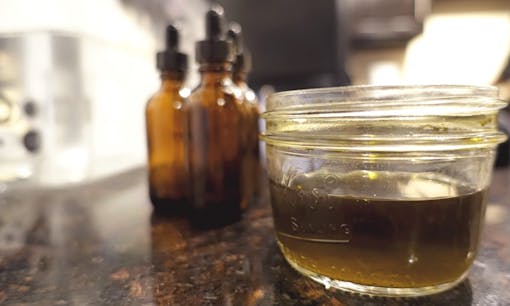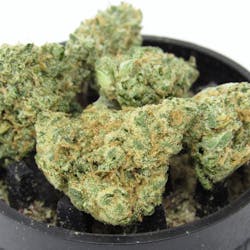In the landscape of cannabis innovations, including rosin vape pens, transdermal topicals, and nanotechnology beverages, tried-and-true classic products can get overlooked.
One of the first innovations in plant medicine, with documentation as far back as 1025 in The Al-Qanoon fi al Tibb, aka, The Canon of Medicine, was the tincture. In the millennium since, there have been innumerable innovations, but we’re here to say that good weed and a good product never go out of style.
What is a cannabis tincture?
A tincture in the most basic sense is a cannabis extract, in which a liquid is infused with cannabis, meant for sublingual consumption, not vaporization or smoking. The cannabis plant soaks in a base liquid, such as food-grade alcohol, glycerin, or even oil, and after days of steeping, the plant matter is strained out and—voilà! The cannabinoids, terpenes, and other compounds have melded with the base liquid, ready to dose and consume.
Technically, the term “tincture” specifically refers to an alcohol-based product and one made with oil or glycerin is an “infusion,” but we’re using it as an umbrella term here.
In the adult-use market, tinctures typically come in 1 fl oz (30mL) glass bottles with droppers to administer low and consistent doses. Because they are not considered a food item, they can exceed the 100 mg THC cap on edibles in many markets.
Tinctures may not seem as fun or innovative as a gummy or a dab, but they have a multitude of health benefits while still offering a comfortable, intoxicating experience.
Tincture vs. edibles
While both tinctures and edibles require ingestion to work, they enter the bloodstream via different bodily systems and will have distinct effects.
Edibles require digestion and are processed in the stomach and liver, and enzymes in the liver enhance the effects of ingested THC. Tinctures do not pass through the liver and are absorbed under the tongue, so while the high will be more immediate, it won’t be as strong.
Shop highly rated dispensaries near you
Showing you dispensaries nearHow does a tincture compare to CBD oil?
CBD oils sold in wellness stores and online bear a strong resemblance to tinctures, but the two differ significantly in some areas.
Namely, a CBD oil not sold in a licensed adult-use or medical marijuana dispensary is typically produced by isolating and extracting CBD from hemp using a solvent, like butane or CO2, and then binding the extract to a carrier oil.
Tinctures are whole plant extracts and even when extracted from compliant hemp plants, they may contain trace amounts of THC.
Additionally, because tinctures are often alcohol-based, they cannot be used as a topical or skin-conditioning product the way CBD oil can. Both, however, can be taken orally to yield CBD’s therapeutic benefits.
Benefits of using cannabis tinctures
While they may not seem as edgy as other consumption methods, tinctures have endured in apothecaries and dispensaries for centuries because they are considered one of the healthiest ways to consume cannabis.
No food allergens or sensitive ingredients
Some brands flavor or enhance tinctures, but you only need the cannabis plant and the base to which it is bound. This means sugar, gluten, gelatin, food coloring, and any other ingredients that may aggravate intolerances or allergies can be avoided.
Discretion
Tinctures at a glance resemble a skincare product or wellness supplement. If sealed, they don’t stink like buds, and they don’t produce smoke or vapor that as with inhalation methods.
Flexible dosing
Tinctures are not beholden to the 100mg edible cap in many markets, so one bottle will last you a lot longer than a tin of gummies or a brownie. You can also control your dose, down to the drop.
Fast-acting
If taken sublingually, tinctures’ effects have a speedier onset than eating an edible, since they absorb through the tissue in the mouth (though it will take a little longer than smoking). This also means tinctures last longer than smoking a joint, but may metabolize faster than an edible made with fats, like baked goods.
Full spectrum
Since tinctures involve soaking the entire cannabis plant, consumers get a myriad of benefits from all the compounds in the plant beyond just THC and/or CBD.
THC tincture dosage guide
This is based on a 300 mg THC, 1 fl oz (30 mL) tincture.
| Dosage in ml | Approximate dose in mg | Effects |
| 0.10 ml | 3 mg | Microdose for very low intoxication |
| 0.25 ml | 7.5 mg | Light dose with low intoxication for beginners and sensitive consumers |
| 0.50 ml | 15 mg | Standard dose with slight intoxication |
| 1 ml | 30 mg | Higher than average dose for experienced consumers |
| 2 ml | 60 mg | Potent dose for experienced consumers or patients with serious ailments |
Learn more about cannabis science.
How to use or take cannabis tinctures

Cannabis companies operating in legal markets are required by law to include accurate dosing information for ingestible products. If you pick up a tincture from your local dispensary, it will have dosing information on the packaging. Most health and CBD stores also provide this, but THC-free tinctures don’t always go through the same degree of testing.
Your ideal dose will depend on your tolerance, as well as the goal of taking the tincture. If the tincture has been formulated for helping with sleep, you may want a single high dose to ensure sedation. If you intend to use the tincture for general daytime wellness, you may find that multiple microdoses throughout the day may achieve a more uplifting experience.

Sour Diesel THCA Flower
28.1% THCA | Chemdawg x Super Skunk
Arete’s Sour Diesel hemp THCA flower is a 90/10 sativa-dominant hybrid grown indoors with living soil. Expect dense green buds with a heavy frost and a classic, loud-diesel aroma. Effects are energetic, creative, and cerebral. Have it shipped to your door in US states that allow hemp flower products!
3.5g, 7g, 14g, and 28g
We may earn a small commission if you buy through links on this page. Availability subject to law.
Rule of thumb, as with anything weed-related, start low and go slow. In a 1 fl oz bottle, one full dropper equates to 1 mL, so we advise starting with a quarter dropper or less if you have a low tolerance or do not regularly consume high amounts of cannabis. You can go for half a dropper if you feel more confident.
For maximum efficacy, use the dropper to deposit the tincture under the tongue, and let it sit for 30 seconds before swallowing.
The mouth has absorbent tissue called oral mucosa, essentially a mucous membrane that lines the inside of cheeks, lips, and under the tongue that helps fight disease and keeps our mouths healthy. It also absorbs tinctures and administers cannabinoids into the bloodstream directly, without going through the stomach or liver.
How long does it take for a cannabis tincture to kick in?
Tinctures typically take effect within 15-30 minutes if left to sit under the tongue for 30-45 seconds. Swallowing a tincture directly can compromise its efficacy as your body won’t absorb it the way it will an edible or food item. Tinctures mixed with food will take longer to take effect, but may yield a more potent high.
Can you cook with tinctures?
Cooking with tinctures depends primarily on the formulation and how you plan to incorporate it into cooking. Since most tinctures contain THC, CBD and/or other cannabinoids that have been decarboxylated, exposing the tincture to high heat via an oven, stove, or boiling water may burn them away, rendering the final food useless from a medicinal standpoint.
However, you can easily add a tincture to the finished dish by incorporating it in a sauce or dressing. They also make good additions to top up cannabis weed tea recipes.
How to make cannabis tinctures

Tinctures are one of the easiest cannabis products to make at home. They require almost little equipment and you don’t need a high level of plant science, but they do need patience.
The ratio of base to flower will determine how concentrated the tincture is. A tincture made from an ounce of cannabis, for example, should be steeped in about 25 fl oz of base liquid for mild doses once in a 1 fl oz bottle. For a more potent tincture, use less of the base liquid or more weed.
Ingredients
- Eighth to a half ounce (3.5 – 14 grams) cannabis flower
- 3 – 12 fl oz. food-grade ethanol, glycerin or a carrier oil, such as coconut oil
Equipment
- Glass mason jars
- Coffee filters or a cheesecloth
- A 1 fl oz glass bottle and dropper cap
Directions
Step 1
Decarboxylate your cannabis. Because no heat is involved in the tincture-making process, you’ll need to activate your buds if you want an intoxicating effect from THC. You’ll need a baking tray, parchment paper, and flower.
To decarboxylate:
Your cannabis should be ground and/or broken down for maximum surface area. Set your oven to between 220-240ºF (going too high will burn away cannabinoids) and lay the cannabis flower on the parchment paper on the tray. Let bake for 30 minutes to no more than an hour—any longer will cook all the good stuff away.
You can leave the plant raw if you prefer to harness the non-intoxicating benefits of THCA and CBDA, the acidic forms of THC and CBD. You may see better results if you grind the bud beforehand.
Step 2
Pour your base and cannabis into a mason jar at your desired ratio; an eighth of cannabis to 3 fl oz solvent yields a fairly mellow and buildable dose. Cut the base amount or increase flower amount by ⅓ for a more potent effect; there needs to be enough of your base for the cannabis to be totally submerged. Stir the contents well.
Step 3
Store your tincture mixture in a cool dry place for at least four weeks, shaking and/or stirring once a day. This agitation helps the base liquid better soak into the flower.
Step 4
Over time, the plant’s cannabinoids and terpenes will dissolve (alcohol) or infuse (glycerin) with the base. A longer steep time will yield a more potent tincture.
Strain the mixture through a coffee filter or cheesecloth to remove all plant matter. What you’ll be left with is a dark liquid full of weedy goodness, ready to dose.
Freeze method
Maybe you don’t have weeks to spare to wait for a tincture to infuse, or you don’t like waiting. Here is an alternative recipe that you can do in a day.
Like in ice water hashmaking, freezing the bud before infusion, but after decarboxylation, helps dislodge the cannabinoid-rich trichomes from the plant. This recipe requires the use of alcohol as your tincture’s base.
Step 1
Decarb your cannabis (see above).
Step 2
Freeze the alcohol and cannabis in separate mason jars overnight. This makes the trichomes more brittle and will help the tincture taste less like plant matter.
Step 3
Mix the alcohol and bud in one mason jar. Seal and shake it for one minute.
Step 4
Place the mason jar mixture back in the freezer for five minutes to ensure contents stay cold and frozen.
Step 5
Repeat the shaking of step 3 and step 4 two more times.
Step 6
Strain the mixture through a filter of your choice to separate plant matter.
Step 7
Bottle your tincture and enjoy!
Alcohol, glycerin, oil: Which is the best base?
Historically, tinctures have been made using an alcohol base. Alcohol cuts through the lipids and plant matter in the cannabis plant so the terpenes and cannabinoids dissolve into it.
Alcohol also helps the tincture enter the bloodstream more efficiently compared to glycerin or another oil.
Keep in mind that when we say alcohol, we don’t mean cocktails or the kind of alcohol you use to clean your bongs. One of the most popular options by far is Everclear, a grain alcohol with proofs as high as 190.
Glycerin-based tinctures will be less potent because glycerin—a sugar alcohol often derived from plant oils, like coconut or soybean—doesn’t bind to cannabinoids as well as an ethanol alcohol. Don’t worry, you’ll still reap many of the tincture’s benefits. Glycerin has a sweeter taste than alcohol and won’t irritate your mouth if you have any oral sensitivities.
Oil-based tinctures are ideal if you want a low, manageable dose, but they bind the least efficiently to cannabis compounds. The upside is that if the tincture isn’t to your liking, you can still use it as a skincare and topical product.
This article was originally published June 16, 2016 and is often updated for accuracy and clarity.




